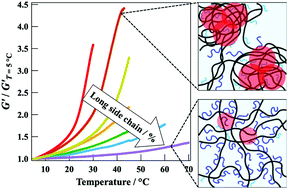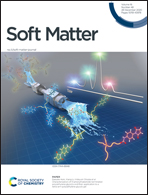Mechanical properties of temperature-responsive gels containing ethylene glycol in their side chains†
Abstract
The mechanical properties of temperature-responsive and biocompatible poly(oligo-ethylene glycol methyl ether methacrylate)-based gels were investigated using dynamic viscoelasticity measurements so as to find applications in tissue and biomedical engineering. The gels were copolymerized using two ethylene glycol methacrylate monomers with diethylene glycol side chains: diethylene glycol methacrylate (MeO2MA), which contains two ethylene oxide units, and oligo-ethylene glycol methyl ether methacrylate (OEGMA) with either four or five ethylene oxide units. The storage (G′) and loss (G′′) moduli of these gels exhibit unique temperature-responsive behavior and depend on the copolymerization ratio. In MeO2MA-rich gels, phase separation occurred with increasing temperature, resulting in a significant increase in G′ and the disappearance of the frequency dependence of G′′. Although phase separation of OEGMA-rich gels was also observed with increasing temperature, it resulted in only a slight increase in the storage modulus due to the steric hindrance of the side chain. The mechanical properties of these gels are thus found to be strongly affected by a slight difference in the number of ethylene oxide groups in their side chains.



 Please wait while we load your content...
Please wait while we load your content...